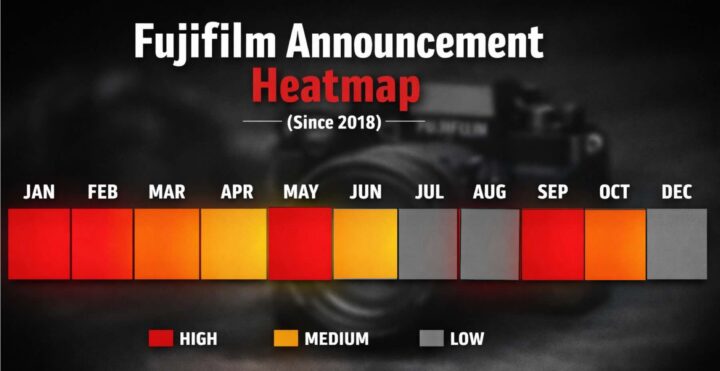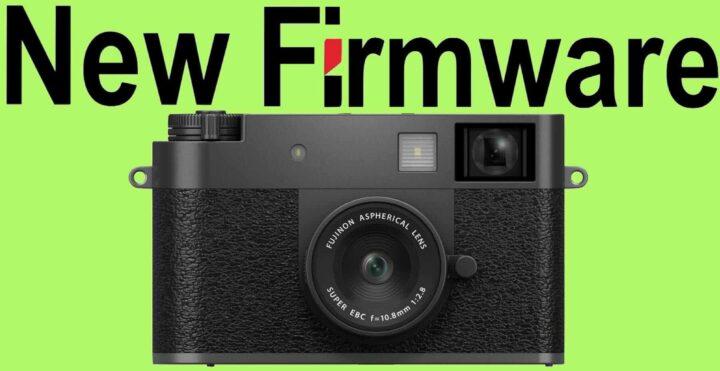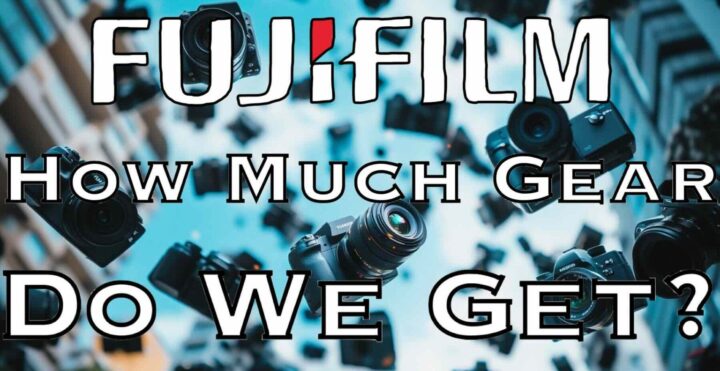These Are Fujifilm’s Favorite Months to Announce New Cameras

When does Fujifilm Usually Announce New Cameras?
As we have seen here, 2026 could potentially be a huge year for Fujifilm.
But the big question now is: when will all that good stuff come?
To get a clearer picture, I went back to 2018 and analyzed which months Fujifilm announced its cameras. Based on that data, the months below are ranked from most popular to least popular in terms of camera announcements.
In Months:
- September: 7 cameras
- May: 7 cameras
- January: 5 cameras
- February: 5 cameras
- October: 3 camera
- July: 1 camera
- March: 1 cameras
- June: 1 cameras
- November: 1 cameras
- April: 0 cameras
- August: 0 cameras
- December: 0 cameras
So, September and May are the hottest months.
However, if we look at quarters, then we get a slightly different picture.
In Quarters
- Q1 – January to March – 11 cameras
- Q2 – April to June – 8 cameras
- Q3 – July to September – 8 cameras
- Q4 – October to December – 4 cameras
The first three months of the year are usually the hottest period for camera releases. And that’s no coincidence.
The Japanese fiscal year ends on March 31, and Fujifilm has a long history of launching high-selling cameras before that deadline. The reason is simple: strong product launches before the end of the fiscal year help Fujifilm present better sales numbers to investors in the final annual report.
In other words, if Fujifilm has a camera it expects to sell well, the January–March window is often when it makes its move.
In Semesters
- first half of the year – 19 cameras
- second half of the year – 12 cameras
The first half of the year clearly wins.
Conclusions
If past years are a reliable indication of Fujifilm’s future, then we should expect a strong first half of the year — with the first three months being especially active.
One Cheap Camera to Rule Them All… in 2025

The camera world has changed.
I feel it in the streets.
I see it in the camera stores.
I read it in the financial reports.
It began with the forging of the great Ten Cameras of 2025.
Four top spots were taken by Fujifilm, the most inspiring and beautiful among all cameras.
Two were taken by Ricoh, immortal and clever in keeping their camera business alive against all odds.
Three were taken by Nikon, Canon, and Sony, who above all else desire to be kings of full frame.
But they were all of them deceived…
For another camera was made.
In the land of New York, among dust-covered factory machinery in Rochester, the Darkroom Lord Kodak forged, in secret, a master camera.
And into this camera, Kodak poured low costs, mass production, and an unrelenting will to flood the market.
One cheap camera to outsell them all.
- Kodak PIXPRO FZ55
- Fujifilm X-M5
- Nikon Z5II
- Fujifilm X-E5
- Fujifilm X half
- Fujifilm X100VI
- Ricoh GR IV
- Ricoh GR IIIx
- Sony A7CII
- Canon EOS R6 Mark II
In other words: these are the ten best selling cameras in Japan in 2025 at Mapcamera.
Fujifilm X half Firmware 1.30 Released

- Fujifilm X half – save $200
BHphoto / Amazon US (black – charcoal – silver) / Adorama / Moment / Nuzira/ BestBuy / Paul’s Photo
Fujifilm X half ver. 1.30 – download here
The firmware update Ver.1.30 from Ver.1.20 incorporates the following issues:
Regarding the details of No.1,2,3,4,5 and 6 download the “X half New Features Guide[Ver.1.30]” from our website.
X half New Features Guide: English, Français, Deutsch, Español, Italiano, Nederland, Polski, Svenska, Norsk, Dansk, Pусский, Suomi, 中文简, 中文繁體, 한국어, ภาษาไทย, Arabic
- You can make prints from instax™ to connect the instax™ Evo and instax™ LiPlay series.
- When [AF MODE] is set to [AREA], you can move the focus frame on the LCD monitor using a swipe gesture.
- You can pull the [Frame Advance Lever] to prepare for the next shot even while recording images with [FILM CAMERA MODE].
- The movie icon is displayed on the nine-frame playback screen.
- Looks & feels of the screen is redesigned to improve the operation for pairing to smartphones.
- The [Direct Print] icon is added to the single-frame playback screen.
When connecting to the instax™ printer, you can print directly through the playback screen just by tapping this icon.
* For details, refer to No.4 in the New Features Guide. - The operation flow is changed so that if you exit [Film Camera] mode without taking a single photo, you cannot develop the film in the X half app.
- Firmware bug fixes
The following bugs are fixed.
1) If you pair your smartphone without setting the [AREA SETTING] at initial setup, the date and time for [AREA SETTING] displayed at the next power-on will differ from the date and time of the smartphone getting at pairing.
2) The preview image is sometimes flicking depending on the brightness of the shooting environment.
3) Setting anything other than [OFF] in [FACE/EYE DETECTION SETTING] menu, the camera freezes when starting movie recording while looking through the viewfinder.
4) When enlarging and previewing a 2-in-1 image and swiping left and right, the displayed image may stop at halfway position.
5) [SHUTTER COUNT] increments unnecessarily.
6) The charging indicator light remains lit occasionally even after the battery (NP-W126S) is fully charged in the camera body.
7) Other minor bugs have been fixed.
How Many Cameras and Lenses Does Fujifilm Release Every Year? And What it Could Mean for 2026

2026 – A Big Fujifilm Year?
2026 could potentially be a huge year for Fujifilm. Fujifilm is going to start to upgrade their cameras to the 6th generation platform.
But how many cameras – and also lenses – can we expect to get in 2026?
Well, let’s take a quick look at how much gear Fujifilm announced in the past years.
Gear released in 2025 – 4 cameras and 3 lenses
- Fujifilm X-T30 III
- Fujifilm X-E5
- Fujifilm X half
- Fujifilm GFX100RF
- Fujifilm GFX Eterna 55
- Fujinon XC 13-33mmF3.5-6.3
- Fujinon XF23mmF2.8 R WR
- Fujinon GF 32-90mm Power Zoom
Gear released in 2024 – 4 cameras and 4 lenses
- Fujifilm X100VI
- Fujifilm X-T50
- Fujifilm X-M5
- Fujifilm GFX100S II
- Fujinon XF16-50mmF2.8-4.8
- Fujinon XF16-55mmF2.8 II
- Fujinon XF500mmF5.6
- Fujinon GF500mmF5.6
Gear released in 2023 – 2 cameras and 4 lenses
- Fujifilm X-S20
- Fujifilm GFX100II
- Fujinon XF8mmF3.5
- Fujinon GF55mmF1.7
- Fujinon GF30mmF5.6 Tilt Shift
- Fujinon GF110mmF5.6 Tilt Shift
Gear released in 2022 – 3 cameras and 4 lenses
- Fujifilm X-T5
- Fujifilm X-H2
- Fujifilm X-H2s
- Fujinon XF 30mmF2.8 Macro
- Fujinon XF 56mm f/1.2 R WR
- Fujinon XF 150-600mm f/5.6-8
- Fujinon XF 18-120mm f/4
Cameras in 2026
So, will there be more than just the two already rumored cameras in 2026?
If we look at Fujifilm’s history (not a rumor), the answer is very likely: yes.
As you can see above. Fujifilm rarely limits itself to just two camera announcements in a year—especially when a new generation of technology is involved. A platform transition usually triggers a cascade of releases, not just a single camera.
If 2026 is truly the beginning of the 6th-generation era, then what we already rumored could just be the tip of the iceberg.
And if Fujifilm maintains the pace it set in 2024 and 2025, there could be 2 more cameras in addition to the ones we already rumored.
It’s your time to guess what else could come ;).
Lenses in 2026
Fujifilm has quite consistently released around four lenses each year, combining both X and GFX series models, except for 2025, when we got 3 lenses.
So far I have no rumors about future lenses, which means you have three/four slots you can fill in with your wishes. :)
Let’s Make it an Awesome Rumor Year :)
If anyone out there can maybe give us a hint on future X and GF lenses, feel free to reach out to FujiRumors. Your help would be greatly appreciated.
Overall, 2026 remains a significant mystery, but I’m hopeful that our trusted sources (and maybe some new ones) will be able to shed light on some of the unknowns and provide insights that will make us even more excited for what’s to come.
Until then, keep shooting, keep enjoying life… and every now and then, keep checking in on FujiRumors ;).


